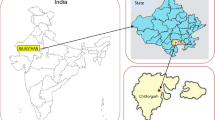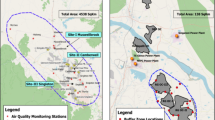Abstract
Tasra coal washery has been planned in Tasra block which is located in Jharia coalfield of Jharkhand state in India. In order to predict air pollution impact because of the proposed washery, modelling has been done using fugitive dust model. Dust levels (PM10 and PM2.5) have been assessed both for conditions of controlled and uncontrolled emissions from various sources of the washery. Baseline site specific air quality data (PM10 and PM2.5) of winter season and maximum coal washing capacity of 700 t h−1 have been considered for prediction of air quality in case of worst-case scenario. Based on modelling exercise, it has been predicted that PM10 concentration may increase from 0.058–51.333 and 0.039–17.485 μg m−3 under the conditions of uncontrolled and controlled emissions respectively at the air quality monitoring sites and the selected receptor locations in the nearby vicinity of the proposed washery. Similarly, PM2.5 concentrations may rise from 0.044–16.636 and 0.022–7.219 μg m−3 due to the uncontrolled and controlled emissions respectively. In order to minimize the fugitive dust levels from the washery site, installation of dry fog dust suppression system has been recommended at different dust generating sources in addition to implementation of other dust control measures in and around the coal washery.









Similar content being viewed by others
References
Ghose, M. K., & Banerjee, S. K. (1995). Status of air pollution caused by coal washery projects in India. Environmental Monitoring and Assessment, 38, 97–105.
Banerjee, S. K., Dhar, R. K., & Ghose, M. K. (1996). Air pollution due to coal washery projects and its abatement measures. Environmental Management, 20, 235–240.
Loveson, V. J., Chattopadhyay, A., & Venugopal R. (2002). Impact of coal preparation plants on nearby fluvial systems and assessment through mathematical modelling and computer simulation. Proceedings of International Conference on Challenges in Coal and Mineral Beneficiation, organized at Indian School of Mines, Dhanbad, India, pp. 303–310.
Sundararajan, M. (2004). Mathematical modelling of fluid components transport for the prediction of environmental parameters in and around coal washery complexes. Ph. D. Thesis, Department of Applied Mathematics, Indian School of Mines, Dhanbad, India.
Orissa State Pollution Control Board (2005). Operating guidelines for processing of consent to establish application for establishment of coal washeries in the state of Orissa. State Pollution Control Board, Orissa, India.
Ministry of Environment, Forests and Climate Change (2010). EIA guidance manual – coal washeries, environmental impact assessment guidance manual for coal washeries. Ministry of Environment, Forests and Climate Change, Government of India, New Delhi, India, Prepared by Administrative Staff College of India, Hyderabad.
Sahu, H. B., Dash, S., & Swar, A. K. (2011). Environmental impact of coal beneficiation and its mitigation measures. Indian Journal of Environmental Protection, 31(8), 691–698.
Sundararajan, M., Loveson, V. J., Chattopadhyay, A., & Venugopal, R. (2005). Air quality prediction in and around coal washery complexes through dispersion modelling and computer simulation. Mineral Processing Technology, 3, 502–511.
Singh, G., Pal, A., Niranjan, R. K., & Kumar, M. (2010). Assessment of environmental impacts by mining activities: a case study from Jhansi opencast mining site - Uttar Pradesh, India. Journal of Experimental Sciences, 1(1), 9–13.
Mandal, K., Kumar, A., Tripathi, N., Singh, R. S., Chaulya, S. K., Mishra, P. K., & Bandyopadhyay, L. K. (2012). Characterization of different road dusts in opencast coal mining areas of India. Environmental Monitoring and Assessment, 184(6), 3427–3441.
Kiruba, J. R., & Sundararajan, M. (2016). Computer simulation modelling of air pollution dispersion in and around coal mining complexes of multi-sources. International Journal of Computer and Technological Application, 9(26), 8–88.
Sundararajan, M., & Kiruba, J. R. (2015). Computer aided air pollution dispersion modelling in and around mining and its allied industrial complexes. International Journal Fuzzy Mathematics Architecture, 9(2), 217–233.
Chaulya, S. K., Chakraborty, M. K., & Singh, R. S. (2000). Prediction of air pollution for a proposed opencast coal mine. Transactions of the Institution of Mining and Metallurgy, Section A: Mining Technology, 109, A118–A124.
Ghose, M. K., & Majee, J. (2000). Assessment of dust generation due to opencast coal mining – an Indian case study. Environmental Monitoring and Assessment, 61, 255–263.
Baldauf, R. W., Lane, D. D., & Marote, G. A. (2001). Ambient air quality monitoring network design for assessing human health impacts from exposures to airborne contaminants. Environmental Monitoring and Assessment, 66, 63–76.
Jones, T., Blackmore, P., Leach, M., Matt, B. K., Sexton, K., & Richards, R. (2002). Characterisation of airborne particles collected within and proximal to an opencast coalmine: South Wales, U.K. Environmental Monitoring and Assessment, 75, 293–312.
Chaulya, S. K. (2003). Assessment and management of air quality in a mining area. Environmental Quality Management, 12(4), 45–59.
Gautam, S., & Patra, A. K. (2015). Dispersion of particulate matter generated at higher depths in opencast mines. Environmental Technology & Innovation, 3, 11–27.
Patra, A. K., Gautam, S., Majumdar, S., & Kumar, P. (2016). Prediction of particulate matter concentration profile in an opencast copper mine in India using an artificial neural network model. Air Quality, Atmosphere & Health, 9(6), 697–711.
Chaudhari, P. R., & Gajghate, D. G. (2000). Assessment of air pollution effect on plants – a review. Indian Journal of Environmental Protection, 20, 925–933.
Ahmad, A. F., Sharma, H. K., Ahmad, R. M., & Rao, R. J. (2014). Impact of mining activities on various environmental attributes with specific reference to health impacts in Shatabdipuram, Gwalior, India. International Research Journal of Environmental Sciences, 6(3), 81–87.
Fugiel, A., Korol, D. B., Kolarz, K. C., & Smolinski, A. (2016). Environmental impact and damage categories caused by air pollution emissions from mining and quarrying sectors of European countries. Journal of Cleaner Production, 143, 159–168.
Gautam, S., Kumar, P., & Patra, A. K. (2016). Occupational exposure to particulate matter in three Indian opencast mines. Air Quality, Atmosphere & Health, 9(2), 143–158.
Gautam, S., Patra, A. K., Sahu, S. P., & Hitch, M. (2018). Particulate matter pollution in opencast coal mining areas: a threat to human health and environment. International Journal of Mining, Reclamation and Environment, 32(2), 75–92.
Patra, A. K., Gautam, S., & Kumar, P. (2016). Emissions and human health impact of particulate matter from opencast mining operation – a review. Environmental Technology & Innovation, 5, 233–249.
Central Pollution Control Board (CPCB), 2009. National ambient air quality standard. Ministry of Environment, Forests and Climate Change, Government of India, New Delhi, India.
Chaulya, S. K. (2003). Air quality standard exceedance and management in an Indian mining area. Environmental Conservation, 30(3), 266–273.
Chaulya, S. K. (2004). Assessment and management of air quality for an opencast coal mining area. Journal of Environmental Management, 70(1), 1–14.
Chaulya, S. K. (2004). Spatial and temporal variations of SPM, RPM, SO2 and NOx concentrations in an opencast coal mining area. Journal of Environmental Monitoring, 6(2), 134–142.
Chaulya, S. K. (2005). Air quality status of an opencast mining area in India. Environmental Monitoring and Assessment, 105, 369–389.
Chaulya, S. K., Chakraborty, M. K., Ahmad, M., Singh, R. S., Bondyopadhay, C., Mondal, G. C., & Pal, D. (2002). Development of empirical formulae for determination of emission rate from various opencast coal mining operations. Water, Air and Soil Pollution, 140, 21–55.
Triantafyllou, A. G. (2001). PM10 pollution episodes as a function of synoptic climatology in a mountainous industrial area. Environmental Pollution, 112, 491–500.
Triantafyllou, A. G., Kyros, E. S., & Evagelopoulos, V. G. (2002). Respirable particulate matter at an urban and nearby industrial location: concentrations and variability, synoptic weather conditions during high pollution episodes. Journal of Air and Waste Management Association, 52, 287–296.
Prostański, D. (2013). Use of air-and-water spraying systems for improving dust control in mines. Journal of Sustainable Mining, 12, 29–34.
Chowdhury, A, Saurabh, K., Kumar, S., Chaulya, S. K., Prasad G. M., Singh, S. K., Mishra, K. K., Mandal, S. K., & Banerjee, G. (2020). Application of dry fog system for controlling dust emission from mines and mineral processing plant. Proceedings of National Conference on Advances in Mining, Dhanbad, India, pp. 390–399.
John-Glen, S., & Oliver, L. (2015). Fundamental research in water spray systems for dust control. Transactions of the Institution of Mining and Metallurgy, Section A: Mining Technology, 124(2), 78–82.
Yang, S., Nie, W., Lv, S., Liu, Z., Peng, H., Ma, X., Cai, P., & Xu, C. (2019). Effects of spraying pressure and installation angle of nozzles on atomization characteristics of external spraying system at a fully-mechanized mining face. Powder Technology, 343, 754–776.
CSIR-Central Institute of Mining and Fuel Research (1998). Determination of emission factor for various opencast mining activities, report GAP/9/EMG/MOEF/97, environmental management group, CSIR-CIMFR, Dhanbad, India, sponsored by Ministry of Environment, Forests and Climate Change, Government of India.
Cowherd, Jr. D. (1982). Fugitive emission factor update for AP-42 final report. Research Triangle Park, NC: U.S. Environmental Protection Agency, Industrial Research Laboratory.
Chaulya, S. K., Ahmad, M., Singh, R. S., Bandyopadhyay, L. K., Bondyopadhay, C., & Mondal, G. C. (2003). Validation of two air quality models for Indian mining conditions. Environmental Monitoring and Assessment, 82, 23–43.
Horst, T. W. (1977). A surface depletion model for deposition from a Gaussian plane. Atmospheric Environment, 11, 41–46.
Peavy, H. S., Rowe, D. R., & Tchobanoglous, G. (1985). Environmental engineering. New York: McGraw-Hill.
United States Environmental Protection Agency (1995). User’s guide for the fugitive dust model (FDM), Vol. I, User’s Instruction, Region 10, 1200 sixth Avenue, Seattle, Washington, USA.
Ermak, D. L. (1977). An analytical model for air pollutant transport and deposition from a point source. Atmospheric Environment, 11, 231–237.
California Department of Transportation (1979). CALINE3-a versatile dispersion model for predicting air pollutant levels near highways and Arterial Streets. Office of Transportation Laboratory Department of Transportation, State of Califormia, Sacramento, California 95807, No. FAWA/CA/TL-79/23, U.S.A.
Hanna, S. R., Briggs, G. A., & Hosker Jr., R. P. (1982). Handbook on atmospheric diffusion, DOE/TIC-11223. Technical Information Center: U.S. Department of Energy.
Delfiner, P., & Delhomme, J. P. (1975). Optimum interpolation by Kriging. In J. C. Davis & M. J. McCullagh (Eds.), Display and analysis of spatial data (pp. 96–114). London, UK: John Wiley.
Christakos, G. (2000). Modern spatiotemporal geostatistics. New York: Oxford University Press.
Gautam, S., Teraiya, J., & Patra, A. K. (2018). Spatial statistics, spatial correlation and spatial graph theory in air pollution. Environmental Technology & Innovation, 18, 384–389.
Chaulya, S. K., Trivedi, R., Kumar, A., Tiwary, S. K., Singh, R. S., Pandey, P. K., & Kumar, R. (2019). Air quality modelling for prediction of dust concentrations in iron ore mines of Saranda region, Jharkhand, India. Atmospheric Pollution Research, 10, 675–688.
Acknowledgments
The authors are thankful to Dr. Pradeep K. Singh, Director, CSIR-Central Institute of Mining and Fuel Research (CSIR-CIMFR), Dhanbad, India, for giving approval to publish the manuscript. The authors are also obliged to M/s Steel Authority of India Limited for providing logistic support during the field studies.
Author information
Authors and Affiliations
Corresponding author
Additional information
Publisher’s Note
Springer Nature remains neutral with regard to jurisdictional claims in published maps and institutional affiliations.
Rights and permissions
About this article
Cite this article
Chaulya, S.K., Singh, A.K., Singh, T.B. et al. Modelling for Air Quality Estimation for a Planned Coal Washery to Control Air Pollution. Environ Model Assess 25, 775–791 (2020). https://doi.org/10.1007/s10666-020-09721-x
Received:
Accepted:
Published:
Issue Date:
DOI: https://doi.org/10.1007/s10666-020-09721-x




